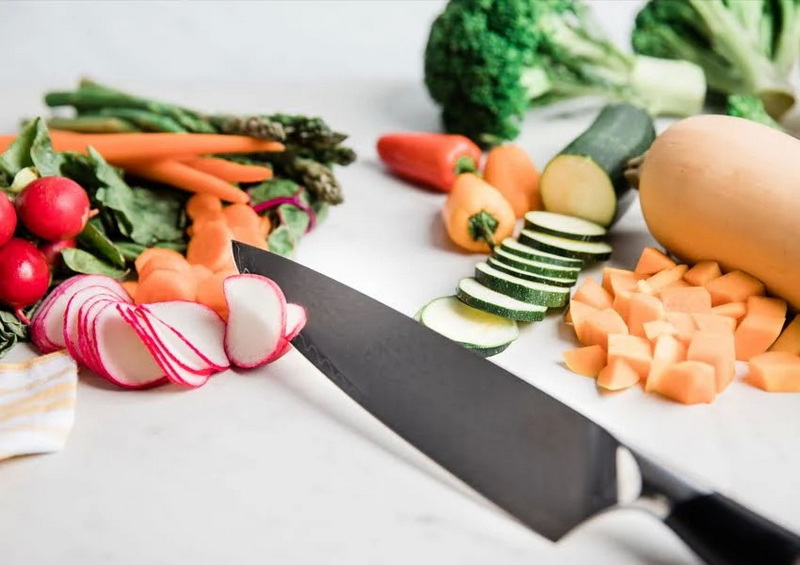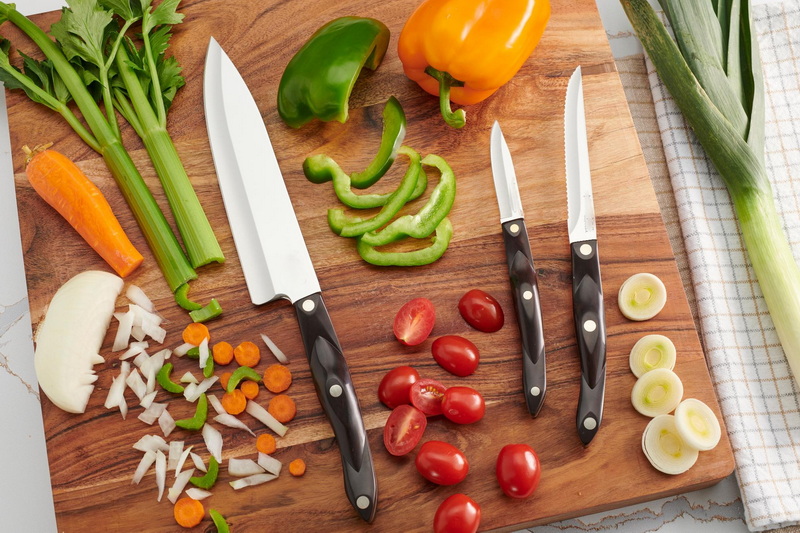

Views: 222 Author: Ella Publish Time: 2025-06-03 Origin: Site








Content Menu
● Understanding China Vegetable Knives
>> Key Features of China Vegetable Knives
● Types of Chinese Vegetable Knives
>> 1. Traditional Vegetable Cleaver (*Pian Dao*)
>> 2. Multi-Purpose Chinese Cleaver (*Wen Wu Dao*)
● How to Choose the Right China Vegetable Knife
>> 2. Blade Size and Thickness
>> 3. Handle Design and Comfort
● Popular China Vegetable Knife Models
● How to Use a China Vegetable Knife
● Additional Care Tips for Your China Vegetable Knife
● Cooking Techniques Enhanced by China Vegetable Knives
● Benefits of Using China Vegetable Knives in Different Cuisines
● FAQ
>> 1. What is the difference between a Chinese vegetable knife and a Chinese chef knife?
>> 2. Can I use a Chinese vegetable knife to cut bones?
>> 3. How do I maintain the sharpness of my China vegetable knife?
>> 4. What blade material is best for a China vegetable knife?
>> 5. How heavy should a Chinese vegetable knife be?
When it comes to cooking Chinese cuisine or preparing vegetables with precision and ease, the right China vegetable knife is indispensable. Known as the Chinese cleaver or cai dao, these knives are versatile kitchen tools designed for chopping, slicing, dicing, and even mincing a variety of ingredients. However, choosing the perfect China vegetable knife can be challenging given the many options available, each with different blade materials, sizes, and designs. This comprehensive guide will walk you through everything you need to know to select the ideal Chinese vegetable knife for your kitchen.

China vegetable knives, often called Chinese cleavers, are characterized by their broad, rectangular blades and flat cutting edges. Unlike Western chef's knives that have a curved edge for rocking cuts, Chinese vegetable knives typically feature a straight or slightly curved edge that excels at an up-and-down chopping motion. This design makes them perfect for chopping vegetables, fruits, and even slicing meat with precision.
- Blade Shape: Rectangular with a length-to-width ratio around 5:3, wider than Japanese Nakiri knives.
- Blade Thickness: Generally thicker than Nakiri knives, around 3-4mm, providing sturdiness for versatile kitchen tasks.
- Blade Material: Typically made from high-carbon steel or stainless steel, sometimes with layered or Damascus construction for durability.
- Handle: Often wooden or composite, designed for ergonomic grip and balance.
- Weight: Balanced to allow controlled chopping without excessive heaviness.
There are several types of Chinese cleavers, but for vegetable preparation, two main types stand out:
- Thicker blade (~4mm), wider and sturdier than Japanese Nakiri.
- Suitable for chopping vegetables, fruits, and light meat slicing.
- Sharp triangular tip for detailed work like trimming fat or making slits.
- Blade belly slightly curved for fast mincing and chopping.
- Versatile edge with thinner slicing area and thicker chopping heel.
- Can handle vegetables, meat, and small bones.
- Ideal for cooks who want one knife for most kitchen tasks.
Choosing the right China vegetable knife depends on several factors, including your cooking style, the types of food you prepare, and your preferences for blade material and handle design.
- High-Carbon Steel: Preferred by professionals for sharpness and edge retention. Requires regular maintenance to prevent rust.
- Stainless Steel: More resistant to corrosion and easier to maintain but may require more frequent sharpening.
- Layered/Damascus Steel: Combines durability, sharpness, and aesthetic appeal with layered construction.
- For everyday vegetable chopping, a blade length around 6.5 to 8 inches (165-200mm) is ideal.
- Thickness around 3-4mm balances sturdiness and sharpness.
- Thicker blades are better for heavier chopping but may be less nimble.
- Wooden handles offer traditional aesthetics and good grip but may require maintenance.
- Composite or synthetic handles can be more durable and hygienic.
- Ergonomic, well-balanced handles reduce fatigue during prolonged use.
- A front-heavy knife aids in chopping by using blade weight to cut through ingredients.
- Lighter knives offer better control for delicate slicing and mincing.
- Choose based on your comfort and the tasks you perform most.
- Carbon steel knives need immediate drying and occasional oiling to prevent rust.
- Stainless steel knives are low-maintenance but still benefit from proper care.
- Hand washing is recommended for all China vegetable knives to preserve sharpness and handle integrity.
Here are some well-regarded China vegetable knives to consider:
Knife Model | Blade Material | Blade Length | Weight | Notable Features |
Tojiro Stainless Steel Cleaver | Stainless Steel | 6.8 inches | 10.7 oz | Compact, sharp, great for small tasks |
CCK Small Cleaver KF1303 | Carbon Steel (Kurouchi finish) | 8.25 inches | 10.7 oz | Sharp, balanced, less food sticking |
Hezhen YM3L Series | 3-layer Stainless Steel | ~7 inches | 278 grams | Comfortable grip, front-heavy for chopping |
Shun Classic Vegetable Cleaver | VG-MAX Steel with Damascus cladding | 7 inches | Balanced | Razor-sharp, corrosion resistant, elegant design |

Using a Chinese vegetable knife properly enhances its effectiveness and safety.
- Grip: Pinch the blade near the handle with your thumb and index finger, wrap the other fingers around the handle for control.
- Chopping Motion: Use an up-and-down chopping motion, letting the knife's weight do the work.
- Precision Cuts: Use the tip for detailed work like trimming or slicing thin pieces.
- Scooping: Use the broad blade to scoop and transfer chopped ingredients easily.
To ensure your China vegetable knife remains in optimal condition, it is important to follow some additional care tips beyond basic maintenance. Avoid using the knife on extremely hard surfaces like glass or stone cutting boards, as this can dull the blade quickly. Instead, opt for wooden or plastic cutting boards that are gentler on the blade. Also, avoid putting your knife in the dishwasher, as the harsh detergents and high heat can damage both the blade and handle.
Regularly inspect your knife for any signs of damage or wear, such as chips or cracks in the blade or handle. Addressing these issues early can prevent further damage and extend the life of your knife.
China vegetable knives are not only great for chopping but also excel in various cooking techniques. For example, their broad blade can be used to crush garlic cloves or ginger by pressing down firmly, releasing more flavor. The flat side of the blade is perfect for smashing ingredients or flattening meat.
The knife's weight and balance make it ideal for quick, repetitive chopping motions, which is essential in stir-frying and preparing ingredients for soups and stews. Additionally, the wide blade allows for easy scooping and transferring of chopped ingredients from the cutting board to the wok or pan.
While primarily designed for Chinese cooking, these knives are versatile enough to be used in various cuisines. Their ability to handle vegetables, herbs, and light meats makes them suitable for preparing dishes in Thai, Vietnamese, Korean, and other Asian cuisines. The knife's design also lends itself well to Western vegetable preparation, especially for those who prefer a straight chopping motion over rocking cuts.
Investing in a quality China vegetable knife can improve your efficiency and precision in the kitchen, regardless of the cuisine you are preparing.
Choosing the right China vegetable knife is essential for anyone looking to master Chinese cooking or simply improve their vegetable preparation. Consider blade material, size, weight, and handle comfort to find a knife that suits your cooking style and needs. Whether you opt for a traditional thick vegetable cleaver or a versatile multi-purpose cleaver, investing in a quality China vegetable knife will enhance your kitchen efficiency and enjoyment. Proper care and technique will ensure your knife remains sharp and reliable for years to come.

A Chinese vegetable knife typically has a broader, rectangular blade with a flat edge designed for chopping vegetables and light slicing. A Chinese chef knife is thinner, lighter, and better suited for precision cuts, including meats and fish. Vegetable knives are usually heavier and thicker for chopping, while chef knives offer more agility for detailed work.
Generally, no. Chinese vegetable knives are designed for vegetables and soft meats. Cutting bones requires a heavier, thicker bone chopper or meat cleaver to avoid damaging the blade.
Regular honing and occasional sharpening are necessary. Carbon steel blades need to be dried immediately after washing and oiled to prevent rust. Stainless steel blades require less maintenance but still benefit from proper care.
High-carbon steel is preferred for sharpness and edge retention but requires more maintenance. Stainless steel is easier to care for and corrosion-resistant. Layered or Damascus steel offers a good balance of durability and aesthetics.
Weight preference varies, but most users find knives weighing between 250-300 grams (8.8-10.5 ounces) comfortable. A front-heavy balance helps with chopping, while lighter knives offer better control for fine slicing.